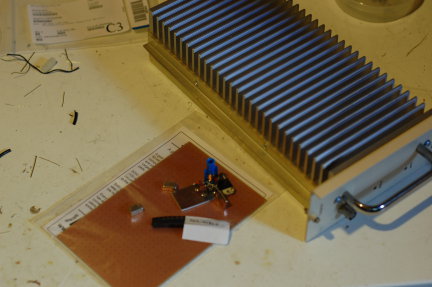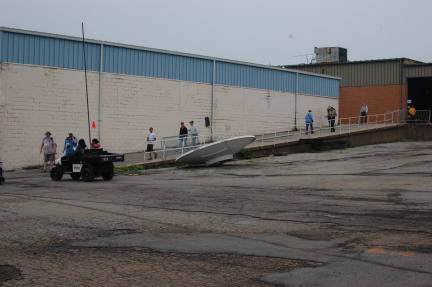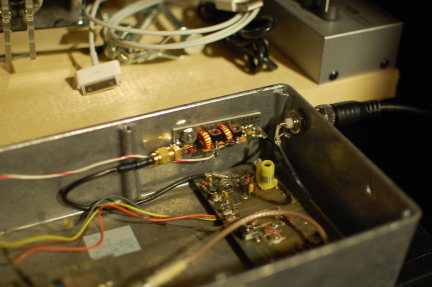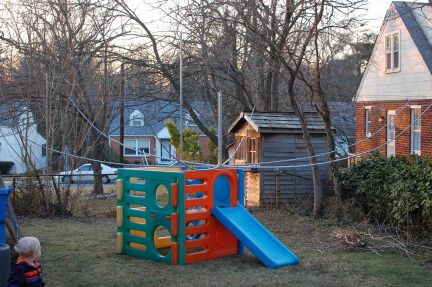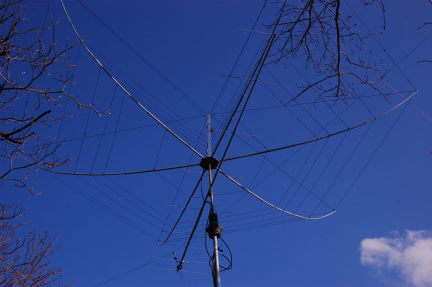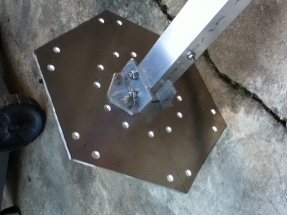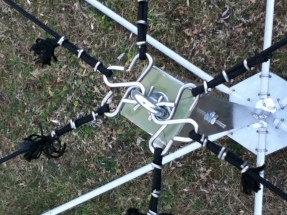Author Archive
 Review: Array of Light (3rd Edition)
Review: Array of Light (3rd Edition)
My friend Matt, KB9UWU, eggs me on to buy things. Sometimes I listen. Sometimes I don’t. But, eventually he wins me over and I’m usually happy with the purchase (e.g., K3 and Hex beam, although I built the Hex from scratch, which reminds me that I owe the blog a discussion of that). I like to think that I let Matt be the early adopter and then pick and choose based on his experience. He convinced me to buy a copy of N6BT’s book Array of Light. Here’s my review.
If there’s anybody that knows antennas in the amateur community, it’s Tom Schiller, N6BT, the founder of Force12 and now owner of N6BT Next Generation Antennas. He’s also a member of the very successful Team Vertical contest team, who have revolutionized DXpedition and contest expedition antenna systems by replacing trapped tri-band Yagis like the TH-3jr(s), TA-33jr, and A3S, with arrays of verticals located at the water line. Schiller’s work has been nothing short of revolutionary so I had high hopes for the book.
My copy, like every other copy, is signed by the author. It’s a good-quality laser print and has the same spiral binding as the Elecraft manuals. The book is a loosely-edited collection of articles and clippings that read pretty well in series. But, it’s bear to skim or go back to find specific things unless you’ve read the whole thing cover-to-cover a couple of times. But, that’s pretty easy to do because Tom is a good storyteller. My only other complaint is that there are a couple of places where I think Tom has drunk his own Kool-Aid regarding the efficiency of his antennas, especially “linear loading.” This is a topic that I need to revisit with a pencil and paper study at some point because there is a lot of misinformation floating around about traps, linear loading, and “multi-monoband” antennas. It’s not clear to me that anyone has sat down and really examined this in a methodical way. It was disappointing that he quoted numbers like “greater than 99% efficiency” without going into more detail about the efficiency of a full-size antenna versus the linear-loaded one, etc. Of course, this is difficult, but it’s something that always makes me a bit skeptical.
Array of Light is worth the price of admission for a couple of reasons—the first is the stories and the second is the antenna designs. I’m a big proponent of not reinventing the wheel on most of my homebrew projects and this book is sure to provide some proven designs to work with. Especially if you want a good discussion of practical antennas for DXpeditioning and contesting I think it’s a real winner.
 Do you see what I see?
Do you see what I see?
- Crystal oscillator for 98.5 MHz. Check.
- TUF-1 and TUF-3 mixers. Check.
- SMT protoboard. Check.
- MMIC amplifiers. Check.
- Larcan TV exciter amp. Check.
Do you see what I see? Yes, a 222-MHz transverter is on the horizon.
 Dayton 2013 Recap
Dayton 2013 Recap
Some good planning on Sarah’s part yielded a bridal shower for her sister scheduled on the same weekend as the Hamvention. Huge win.
- Speaking of huge wins, there was no sewer back up this year.
- Like the last time I attended in 2011, I’m pleased to see more younger (than me) hams in attendance. A high-ranking ARRL official noted to me the “energy and enthusiasm” present in this generation of young hams that was not present 15 years ago (this year marks my 20th year as a ham, but I didn’t mention that). Attendance was still thin compared to my first visit in the mid 1990s.
- Deals. I stimulated the economy by purchasing a small CDE rotor for my VHF activities, an HP server power supply for a future solid state amplifier project (>55 amps at 50 volts), a couple of 900-MHz antennas, and some miscellaneous small parts. I sold some junk to partially cover that expense.
- People. Ran into a lot of old friends and made some new ones. This is really why I go to Dayton, well, that and the junk. K8MFO tells me there are Bureau cards coming. W8AV has 930s for me to work on. W2NAF had people for me to meet. AD8P was able to win himself a pizza from an unnamed W5 in the “SB-200 challenge” of correctly differentiating an SB-200 from an SB-220 at a distance of 20 feet—a tribute to the W5′s failure to distinguish the two until after the sale last year.
- W2NAF has written an article about our trip to Adak (NA-039) that was published in the June 2013 issue of CQ. It has a lot more background detail than what I wrote on the blog. Check it out. I picked up a copy of that and the May 2013 issue which has the 2012 CQ WW CW results in it.
- Products. I just don’t care that much about new products. The Ten-Tec Rebel that several people have already discussed is a cool idea. I know that Ten-Tec took some flak for not opening up the Orion SDR core when they produced it. But, let’s be realistic, people. Hams would have bricked those suckers in a heartbeat. A sandbox “open source” radio is a step in the right direction, but I question what a ham can really customize that matters without screwing it up. Maybe I’m just not visionary enough. Almost 10 years ago now, I interned in the R&D lab at a large consumer appliance manufacturer as an undergraduate my supervisor was always saying, “How can we make this attractive to the [hardware] hackers?”
- Guns. The Hamvention web site was very specific that the Trotwood Police Department would be actively enforcing Hara Arena as a non-gun zone. Seriously? It’s a ham radio convention. Bill Goodman is there at least once a month the rest of the year. Do hams bring their go-kits to gun shows? They must. Inquiring minds want to know…
- Suites. I did not do the contester suite thing. Was thinking of going on Friday night but fell asleep in my in-laws’ living room. This is a recurring problem when I visit so no one bothered to awaken me.
Was the trip worthwhile? I think so.
 W3APL/B 903-MHz beacon
W3APL/B 903-MHz beacon
Late last Summer, it came to my attention that the 903-MHz W3APL beacon had gone off-line. The failure was intermittent and seemed to resolve itself after power was reset. Several efforts to troubleshoot it were undertaken by myself and others, including running it at high duty into a dummy load over a period of days. I was unable to get the problem to manifest itself on my bench.
A synthesized source (Analog Devices demo board) was offered by a friend of the Club, however it did not produce the desired output (or any output at all). It’s not clear whether this was the fault of the synthesizer or the user (me). The notional plan was to replace the beacon, which consists of a 75-MHz crystal oscillator followed by 12x of multiplication and a small RF power module, with the synthesizer and a new RF power module. The project languished, as they often do in my hands. But, two weeks ago I picked up the task again and made some real headway.
Really, the failure had to be one of a couple of things: 1. Intermittent connection exacerbated by thermal cycling. 2. Oscillator “unlock” due to component aging and thermal cycling. I reasoned that as long as we could eliminate #1, the multiplier chain and amplifier should be fine. The behavior seemed to point toward #2 or perhaps a combination of #1 and #2. I came across a forlorn Programmed Test Sources PTS-040 that I had rescued from another group’s surplus heap to put in my lab. I hadn’t used it in the two years that it was in my possession, so it seemed logical to provide it to the Club on a long-term loan. The problem was that it didn’t go up to 75-MHz. So, I cooked up a little multiplier chain. My “good” HP spectrum analyzer is on-loan to a paying program so I had to make do with the FFT function on the fastest Tektronix portable scope I had in the lab.
My initial effort at the multiplier chain was to build a 2N3904 amplifier that swung way into saturation producing a signal rich in harmonics. I went straight away for the 903-MHz signal but I couldn’t get a good enough lumped-element filter to eliminate the adjacent harmonics. So, I tried for the 75-MHz injection. This demanded a buffer amplifier so I lazily reached for the MMIC drawer in and retrieved one of the plentiful MAR-8s. Plenty of gain…and, as I would find out in a moment…conditionally stable! To exercise the eloquent euphemism of Ben, N3UM, the MMIC “burst into song” at about 63 MHz.
Back to the drawing board. I knew that I had something that would work, so I redesigned the deadbug layout on an SMD protoboard (the kind with all the pads in a grid). I replaced the discrete 2N3904 and MAR-8 MMIC amps with SGA-4586Z MMICs (which are a little too nice for this service, but I have a ton of them). Viola!
It’s the little board on the far wall of the diecast box with the SMA connector on the left and two toroids. 37-MHz RF comes in from the PTS-040 through the BNC jack in the wall. It’s multiplied up to 75 MHz on the new board and piped down to the remaining 12x multiplication and amplification stages before going to the little brick PA in the lower left (not visible).
So far, it sounds good. I was able to monitor it with my W1GHZ transverter strapped to the IC-290A in my car and using a WA5VJB cheap Yagi tossed in the back seat. I lost the signal about 5 miles away with that setup, which is really pretty decent all things considered at that frequency, etc, etc. Nominally, the frequency should be 903.054 MHz. I found it at about 903.048 MHz on the lash-up. Brian, ND3F (aka N3IQ/R) reported that he found it at 903.046 MHz with KA3EJJ’s setup. If you’re in the vicinity of FM19ne and are setup on 902/903, we’d appreciate a report. The big thing is the long-term stability. So, we’ll continue to monitor it.
Now…to get back to that 930 on my bench…
 More Hexbeam
More Hexbeam
“What have you done to my play set?” This gym made a convenient place to string wires, etc. Two poles in the photo form part of the EWE RX antenna here at K8GU that was hastily erected before the NA Sprint CW. One of the poles is ty-wrapped to the play set. Doing my best to keep it klassy and impress the neighbors.
And, we’re up in the air! The M2 9M2SSB is a little bit out of alignment due to the hex getting tangled in one of the antennas that it was due to replace. I have already realigned that. So far, the antenna seems to have useful front-to-back. Gain is hard to tell since I took down all of the antennas it was to replace. But, it does seem to work. I’m suffering from high SWR (above 3) on both 21 and 50 MHz. G3TXQ warns of interaction between 18 MHz and 50 MHz. Do not yet know the cause, but I’m looking into it.
Although the antenna is relatively easy to handle, I don’t plan to make a habit of taking it down for work. Speaking of taking down, the 40m dipole whose center insulator is just visible behind the reflector of the 2-meter beam will be replaced by an as-of-yet-secret antenna.
 The Elecraft Effect
The Elecraft Effect
Heard this on the radio the other day on my way to work. Does it explain, at least in part, the popularity of Elecraft products?
In other news, the blog has been silent for a while, but that doesn’t mean things haven’t been happening. I have a couple of challenging projects that have been taking up the usual blogging time. Stay tuned!
